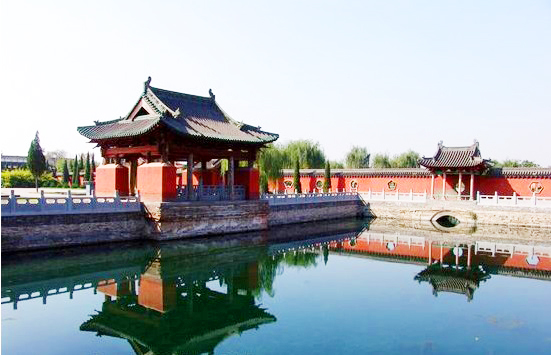Jiyuan: Key source of China’s creation myths

The Jidu Temple in Jiyuan City, Henan Province
Nüwa myths represent key elements of Chinese mythology surrounding the creation of man. Regarded as a deity of ancient China, Nüwa has always been a focus of mythological research.
In addition to historical documents, oral legends are one important aspect of studying Nüwa myths. Jiyuan City in Henan Province is regarded as one possible origin of the Nüwa myths, thus it was given the title “Land of Nüwa Myths” by the Chinese Folk Literature and Art Association.
Jiyuan City, known as the origin of the fable The Old Man Removes the Mountains, is adjacent to Wangwu Mountain and Taihang Mountain on its north side and to the Yellow River on the south. The city is so named because of the Jishui River. In ancient times, the Jishui River, the Yellow River, the Yangtze River and the Huaihe River were called the “Four Rivers” of China. The Jidu Temple was used for offering sacrifices to the Jishui River and the North Sea God by the Sui, Tang and later dynasties. It is now a key focus of national cultural relics protection and the best preserved among all the four river temples.
According to historical materials, Nüwa first appeared in the text of Heavenly Questions in Chu Ci, an anthology of Chinese poetry; and Da Huang Xi Jing in Shan Hai Jing, a classic compilation of early geography and myth.
Among all the Nüwa myths, the creation myth that Nüwa fashioned human beings from yellow clay is the most popular. According to a survey conducted by professor Yang Zeling from the School of Literature at Zhengzhou University, the most circulated edition in Shaoyuan Township of Jiyuan City is as follows:
After passing through Xi Bian Tian, Niang Niang Yao and Shu Zhuang Tai, Nüwa arrived at the Yellow River near Shaoyuan. She saw her own appearance in the water and came up with the idea of molding figures in her likeness with yellow clay. As she worked, the figure came alive - the first human being. Nüwa was pleased with her creation and went on making more figures of both men and women. The fable has prominent characteristics of the Shaoyuan area, and there are various versions in other areas around the country.
In addition to the Nüwa tales, many other myths are also popular in Shaoyuan. Through interview with locals and documents, reporters found that almost all the Chinese creation myths can be found Shaoyuan versions, like Pangu Creates the World, Nüwa Mends the Heavens, Yellow Emperor Fights Against Chiyou, Fuxi Draws Eight Diagrams, Shennong Tasted Hundreds of Herbs, and Zhuanxu Defeats Gonggong.
In 2008, the “mythology group in Shaoyuan” was listed as a form of national intangible cultural heritage. Scholars identified three features of Shaoyuan mythology: myths are passed down through oral transmission; they are widely spread, and almost everyone is familiar with them; and they come in many varieties with hundreds of myths having been collected.
Myths are an extension of ancient people’s life experience and imagination about natural phenomena, especially about rivers and climate. Flood mythology represents a significant part. Because Jiyuan was close to rivers and mountains, scholars believe that geographically the city had ripe conditions to create myths. For example, in a Chinese creation myth, Fuxi and Nüwa, a brother and sister, created human beings with clay because they were the only survivors of a great flood. The flood myth is believed to have originated with an overflow of the Yellow River.
Archaeological excavation found that historical sites in Shaoyuan span from ancient China’s Peiligang culture, Yangshao culture and Longshan culture. Many sites were concentrated in the east of Jiyuan, where the ancient Jishui River flowed. A lot of prehistoric cultural relics were unearthed in this area, showing that in ancient times, Jiyuan was an important region where remote ancestors lived.
Historical documents serve as an important basis for discovering the origin of myths. However, there are not many records in Jiyuan indicating it as the origin place of Nüwa myths. One possible explanation is that most materials about Nüwa don’t clearly point out the actual geographical place, which poses challenges to research in this field.
